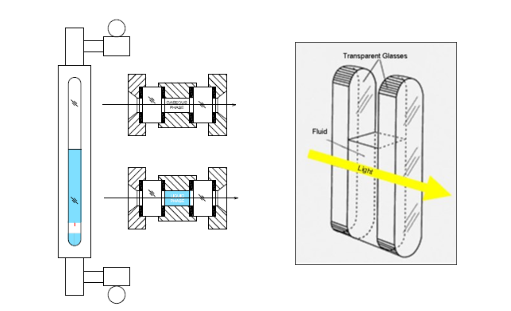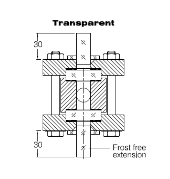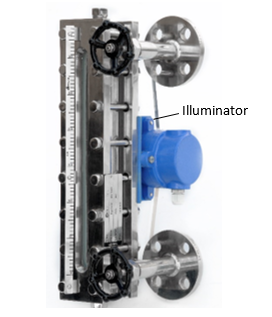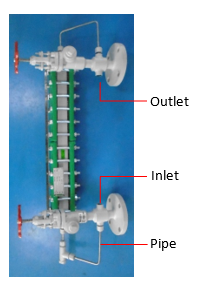Support
FAQ - Transparent Level Gauge (TFG)
1.For which applications/ services TFG is suitable?
It is used for safe visual indication of clean liquids, liquid-liquid interface level indication, colored liquids, aggressive / corrosive liquids, steam water under high temperature & pressure.
2.Whether TFG is used for interface liquids?
Yes
3.What wetted part materials are available in TFG?
CS, CS ASTM A105, SS304/316/316L.
4.What type of glass is used in TFG?
It is a tempered/ toughened borosilicate transparent flat glass with high transparency.
5.How transparent gauge works? how level is observed?
Two flat glasses are placed at front & rear side of the liquid chamber and liquid level is observed through the glass.

6.What is the CC distance range available in TFG?
200 to 2200 mm
7.Whether TFG can be used for large tanks?
Yes. For large tanks, multiple TFGs are installed on tank in staggered arrangement. However, dual TFGs with flanged coupler arrangement can be provided upto 3000 mm. Necessary support should be provided for the same at site.
8.What is difference between coupler and staggered arrangement?
- Coupler arrangement
1. Two gauges are connected to each other with coupler flange arrangement.
2. Only two process connections are required to mount level gauge.
3. The liquid level cannot be observed at the location where the gauges are connected. (200 mm aprox.) 4. Necessary support for the gauge should be provided at site.
- Staggered Arrangement
1. Two or more gauges are installed on the tank with overlapping
2. Process connections will be more than two.
3. No. of process connections = 2 x no of gauges 4. Provides continuous visibility
9.What is the difference between straight- through and hook-up type of TFG?
- Straight through TFG (Top-Bottom Connection) - In this construction, end blocks are connected at top and bottom of the liquid chamber and hence visibility of the gauge is lesser than the CC distance.
- Hook - up TFG (Side-Side Connection) - Here end blocks are connected to side of the chamber and visibility of the gauge is same as CC distance.
10.How much bottom clearance from lower nozzle to ground is required to install TFG on tank?
Bottom clearance required is approximate 300 mm in case valve is required at drain.
11.What is temperature range TFG is suitable for?
TFG in metallic construction is suitable for temperature -40 to 400 °C
12.What maximum pressure does TFG is suitable for?
- It is available in four pressure ranges as under
- Low pressure – vacuum to 30 kg/cm2
- Medium pressure – vacuum to 85 kg/cm2
- High pressure – vacuum to 165 kg/cm2
- Very high pressure – vacuum to 210 kg/cm2
13.What is least count of the scale?
Calibrated scale is available in SS304 MOC with LC of 5 mm or 0.5 cm or ¼”
14.How does auto ball check work?
Auto ball check (ABC) facility is provided as safety feature to prevent liquid loss in the event of glass break. It consists of capsule and freely moving ball along its inner race between stopper and orifice. It is placed in the neck of end block at bottom and top side. In case gauge glass breaks, high pressure from vessel side (atm + liquid column) moves the ball to block the orifice and minimize liquid loss from tank.
15.What is the use of integral offset gauge valve?
Integral offset gauge valve – It is an integral part of end block used in gauge at top and bottom to regulate liquid flow coming inside the liquid chamber. By opening needle valve, liquid in the tank can be observed through glass. During maintenance, cleaning of glass or its replacement can be done by closing the offset valve.
16.When frost free extension is recommended with TFG?
It is recommended for clear visual reading of low temp liquids. It is used to prevent frost formation on gauge glass.

17.When Illuminator is recommended in TFG?
It is recommended for installation of gauge in poorly lit area. Illuminator is fitted on rear side of the chamber, it provides uniform light along the glass length for clear visual indication It consists of Perspex reflector, illuminated through a LED bulb, 80 to 250 VAC with Al. Enclosure IP65 /Ex d Gr. IIB or IIC. The length of single illuminator is 1200 mm max.

18.When Jacketing is recommended in TFG?
It is recommended for liquids, which gets solidified at amb temp. It prevents solidifcation of liquids at amb. temperature. It consists of a SS pipe, which pass through liquid chamber with inlet & outlet of ½” NPT (F) at bottom and top end block of gauge. Heating (steam) / cooling agent is passed through this pipe to maintain service material in liquid state.

19.What is standard process connection orientation in TFG?
Standard process connection orientation is rear – rear. However, it is available in left-left, right-right orientation as required in straight through connection only. (Note: TFG hook-up is not available in left x left and right x right orientation)
20.Whether TFG is used for steam applications?
Yes. IBR approved gauge is available.
21.What is maximum temperature & pressure of IBR TFG?
Max. temperature – 300°C and max. optg. pressure – 80 kg/cm2
22.What information is required to get quotation at earliest?
Tank size, CC distance, process connection, liquid, operating temp & pressure.
23.What are advantages of TFG?
- Robust & safe design for high temp & pressure applications
- Direct visual indication of liquid, colored liquid and interface liquids
- Available with mica sheet for steam applications
- No need of power supply • Easy to install through flanged or screwed connection
- With integral offset needle valve, performing maintenance tasks or cleaning the glass becomes a much simpler process.
24.How TFG is installed on tank?
It is screwed/ bolted to process connection provided on side wall of the tank. Ensure mounting is in plumb. Use appropriate gasket between the process connection to prevent leakage.
25.What approvals & certifications are available for TFG?
• CE
• IBR
• Material certificate 3.1
• NACE
All Rights Reserved © 2021 PUNE TECHTROL PRIVATE LIMITED
Engineered by THE IMPALS